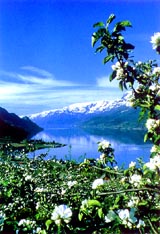
 Norway
Norway

 Today cultural life in Norway finds expression in a variety of different fields such as the theatre, films, music, painting, arts and crafts, folk dancing and literature.
Today cultural life in Norway finds expression in a variety of different fields such as the theatre, films, music, painting, arts and crafts, folk dancing and literature.
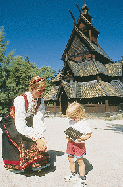 Cultural life in Norway is very varied and many Norwegian artists have achieved international fame. People often wonder how a small country as Norway has been able to produce such a variety of great artists, but feel that it perhaps can be explained to some extent by the tradition of education for all, food for everybody and the absence of war.
Cultural life in Norway is very varied and many Norwegian artists have achieved international fame. People often wonder how a small country as Norway has been able to produce such a variety of great artists, but feel that it perhaps can be explained to some extent by the tradition of education for all, food for everybody and the absence of war.
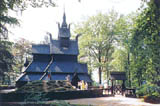 Stave churches
Stave churches
Norway has wonderful old churches called Stave churches, they are mainly built of wood and have roof tops of many angles.
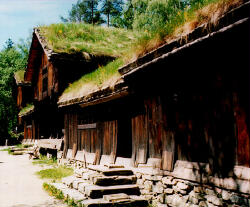 Houses
Houses
A unique and traditional way of building houses in Norway is still seen today.
Though not common many houses still have the traditional grass turfed roof.
This was used as a wau of insulating the house against the very cold tempratures.Maintenance was done by putting the goat on the roof to give it a tidy trim
Norway's national flower is the purple heather, which grows in almost all parts of the country from the coast and high up into the mountains. It blossoms in the summer with small, pink petals, which provide nectar for bees and other insects.
It blossoms in the summer with small, pink petals, which provide nectar for bees and other insects.
Norway's national animal is the elk. It is the largest mammal in Norway and can be found in considerable numbers throughout most of the country. Elks live mainly on grass, leaves, bark and other plants
 The Norwegian Fjord Horse is one of the world's oldest and purest breeds. It is believed that the original Fjord Horse domesticated over 4,000 years ago. Herds of wild Fjord Horses existed in Norway after the last ice age.
The Norwegian Fjord Horse is one of the world's oldest and purest breeds. It is believed that the original Fjord Horse domesticated over 4,000 years ago. Herds of wild Fjord Horses existed in Norway after the last ice age.

Archaeological excavations at Viking burial sites indicate that the Fjord Horse was kept by them over 2,000 years ago.
One of their unique characteristics is that approximately 90% of all Fjord Horses are brown dun in color. The other 10% are either red dun, gray, pale dun, gold or yellow dun.
Another unique characteristic of the Fjord Horse is the mane. The center hair of the mane is dark (usually black) while the outer hair is white. The mane is cut short so it will stand erect
Famous Norwegian things
 Norway's most famous author, Henrik Ibsen, found inspiration in folk tales when writing his play "Peer Gynt" and most people have heard "In the Hall of the Mountain King", music which was written for the play by Edvard Grieg, one of their greatest composers.
Norway's most famous author, Henrik Ibsen, found inspiration in folk tales when writing his play "Peer Gynt" and most people have heard "In the Hall of the Mountain King", music which was written for the play by Edvard Grieg, one of their greatest composers.
Henrik Ibsen was from Bergen.
Ibsen's "Peer Gynt" is often produced at Den Nationale Scene in Bergen during summer.
 The Norwegian painter, Edvard Munch, is today regarded as one of the greatest of modern artists. Although he is perhaps most famous for the painting "Scream", he painted many other outstanding works.
The Norwegian painter, Edvard Munch, is today regarded as one of the greatest of modern artists. Although he is perhaps most famous for the painting "Scream", he painted many other outstanding works.
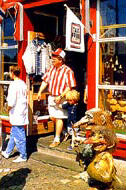 When shopping in any tourist or folk shop in Norway you cant help but notice the trolls, trolls are everywhere in any shape and size. There is a lovely huge statue of the Wood troll in Voss.
When shopping in any tourist or folk shop in Norway you cant help but notice the trolls, trolls are everywhere in any shape and size. There is a lovely huge statue of the Wood troll in Voss.
Legends about trolls or "the little wood folk" are in all Norways myths.
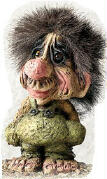 Brown goat's cheese
Brown goat's cheese
- is a Norwegian speciality to be found in every home. A rather sweet cheese made of goat's milk and cow's milk.
The cheese slicer
-was invented in 1925 by a Norwegian, Thor Bj�rklund. It is designed to cut thin slices of cheese, particularly brown goat's cheese.
The paper clip
- is also a Norwegian invention. Johan Vaaler designed this useful article in 1899.
School patrol
School children from about 12 years of age often take part in what we call "school patrols". Their job is to make sure that motorists stop at pedestrian crossings for children on their way to school. These patrols are trained in their duties by the police. They wear easily-recognizable uniforms and use special flags to indicate when it is safe to cross the road.
Packed lunch
 -is a very Norwegian custom. When they leave home in the morning for school or for work, most children and their parents take with them a homemade lunchpack, usually open sandwiches with cheese, ham or other cooked meats.
-is a very Norwegian custom. When they leave home in the morning for school or for work, most children and their parents take with them a homemade lunchpack, usually open sandwiches with cheese, ham or other cooked meats.
The Hardanger Fiddle
-is a native Norwegian instrument, traditionally used in folk dancing. It looks very much like an ordinary violin but has a unique sound which derives from an extra set of resonating strings beneath those played upon. Hardanger fiddles are often richly decorated.
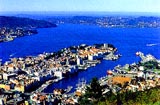
North in Norway is Trondheim. Since Norway is a narrow country around this area (squeezed between Sweden and the ocean), this city has proved to be a good place for gatherings of vikings.
That is why Tronheim can celebrate its 1000 years anniversary in 1997 - it is the oldest city of Norway.
Nowadays, the city is known for the Norwegian Institute of Technology (which in connection with SINTEF is the leading 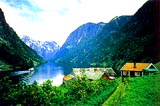 research company in Norway), and its very good student environment.
research company in Norway), and its very good student environment.
One of the spectacular sights of the Norwegian landscape is the magnificent fjords.
The fjords are the geological result of the last ice age, gouged out by mighty glaciers carving their way from the central mountain ranges to the sea.
The largest and perhaps most famous are Sognefjorden and Hardangerfjorden with their numerous tributaries. However, there are many more, with Norway having such a long coastline to form the wonderful and unique fjords .

In Lysefjorden not far from the oil-capital of Norway, Stavanger, we find Prekestolen ('the pulpit'). Rising 597 meters (2,010 feet) up from the sea, it is flat as a floor on the top, where you have a magnificent view.

Norway has a long and craggy coastline of 3,420 km/ 2,125 mi, with many islands dotted in the coast and fjords. Norway called almost be called the land of bridges as that is what is most apparent especially when visiting by sea.